Demonstrating the value of openness and broad support from partners:
In terms of openness and broad support we’ve done very well… Literally available on over 150 different handsets. It’s available from over one hundred different mobile operators around the world. We will probably license about 20 million devices this year which is really quite dramatic at least among smartphone systems. So we have great momentum. We’ve brought [a new version] to market. We’re driving forward on our future releases. We’ll have to see what [the competition] does. Right now they have a press release […] We have many many millions of customers, great software, many hardware devices and they’re welcome in our world.
Inspired by a tweet from Charles Arthur.
[Update]
The quote is Steve Ballmer speaking in 2007 soon after the announcement of Android and in response to a question of what he thought about Android. The source video is here.

